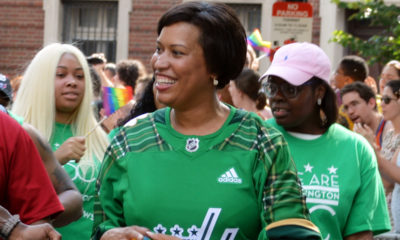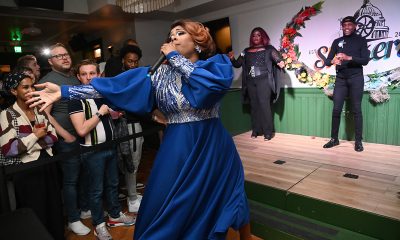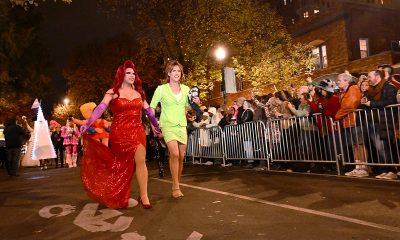a&e features
He loves Annie’s and will until the end
Mano continues to bring infectious passion to his job at iconic restaurant

It’s rare for a restaurant to thrive for more than 75 years. Rarer still is a restaurant whose history is so deeply intertwined with the growth and resilience of a minority community. Annie’s Paramount Steakhouse in Washington, D.C.’s Dupont Circle is one of those exceptional places — a cornerstone not only for the city of Washington, but also for its vibrant queer community.
Several factors contribute to a restaurant like Annie’s becoming a foundational space of cultural and historical significance. Its welcoming atmosphere, fostered by a warm and inclusive staff goes beyond mere hospitality. The decor doesn’t just acknowledge Washington’s LGBTQ community — it proudly celebrates it. And, of course, the award-winning food and drinks leave a lasting impression, making Annie’s a true icon in the nation’s capital.
When walking down 17th Street, where Annie’s is located after 76 years (even after moving three blocks north of its original location on 17th in 1985), it becomes understandable how this stretch of street has always been the heart of the “gayborhood,” regardless of season or political administration. The rainbow flags on nearly every light pole and stickers in nearly every window signal this place is not only a safe space for the LGBTQ community, but a place where being queer is worth celebrating.
Annie’s Paramount Steakhouse has long been a beacon of unwavering support for the LGBTQ community, particularly during times when openly identifying as LGBTQ was met with societal stigma or worse. This dedication, which started back in 1948, has cemented Annie’s as more than just a restaurant — it’s a queer haven and cultural landmark.
Georgia Katinas, the general manager of Annie’s and granddaughter of Annie’s founder George Katinas, told the Blade supporting the D.C. LGBTQ community is a key part of running Annie’s.
“I see Annie’s as a pillar of the LGBTQ community, and it’s important to me to continue that legacy,” said Katinas. “Getting involved in our community in many different facets, supporting LGBTQ nonprofits and organizations, hosting kickball brunches, hiring LGBTQ/queer members of the community — all of that’s incredibly important to me, and it’s an honor. I take the family legacy very seriously, and I really am proud to continue it and to show up on behalf of my family and on behalf of the community and continue to be here.”
One of Annie’s unique legacies is its connection to the High Heel Drag Race, a beloved LGBTQ event on the Tuesday before Halloween. It started as a race between Annie’s and gay bar JR.’s in 1986, and has grown into a vibrant mini Pride celebration on 17th Street now managed by the mayor’s office.
Although it takes a collective effort to transform Annie’s into the James Beard Award-winning restaurant it is today, one server has stood out for decades. Since 1975, his infectious attitude and heartfelt care have made him a cornerstone of the Annie’s experience, drawing loyal customers back time and again.
Mano, with his instantly recognizable horseshoe mustache and ever-present smile, has been a key part of the institution that is Annie’s for as long as most regulars can remember. Hired as the first male staff member in 1975, Mano has remained a key face for the restaurant going back to when Annie herself served food on the dining room floor.
“We treat every customer like a member of our family,” Mano told the Blade during a recent interview discussing his lengthy career in the restaurant. “Ninety-nine percent of the people feel like regulars, and that 1 percent are on their way to becoming them.”
For 49 years, Mano has been a beloved fixture at Annie’s, his passion for the job evident to everyone around him — from coworkers behind the bar to guests in the booths. Known for gestures like cutting steaks for diners, Mano’s dedication once saw him working seven days a week, a testament to his love for being part of the Annie’s team.
“I feel every day better than the day before,” he said. “I love the people more than the day before. I look forward to loving them more. I can’t predict the future. The past is experience. Right now, at the moment, I am enjoying it.”
Despite his glowing appreciation for Annie’s, Mano has had to cut back from working at the restaurant as much as he once did. As he has grown older, Mano has slowly taken a day or two off from his work schedule.
Katinas became emotional when reflecting on Mano’s history with the restaurant.
“He wants the guests to have the perfect experience,” Katinas said. “He takes training very seriously. He has his own systems for how he counts money and uses the computer. He’s very particular but always so kind about it. When I watch him train new people now, I remember when he trained me. It’s very intentional and intense in moments because he cares so much.”
Mano’s presence and unwavering commitment to delivering impeccable service at Annie’s elevates him above many in the food service industry. His contributions also reinforce Annie’s cornerstone role in Washington’s queer history. When asked what sets his legacy—and by extension, Annie’s legacy within the LGBTQ community—apart from that of a server at any other restaurant, one word stood out in his response: respect.
“Give yourself some respect,” Mano said. “Give them [the customers] all the respect you want for yourself. If you cannot respect yourself, you cannot respect anyone else. I am a mirror reflecting you. When you are sitting at the table, I am a mirror reflecting you.”
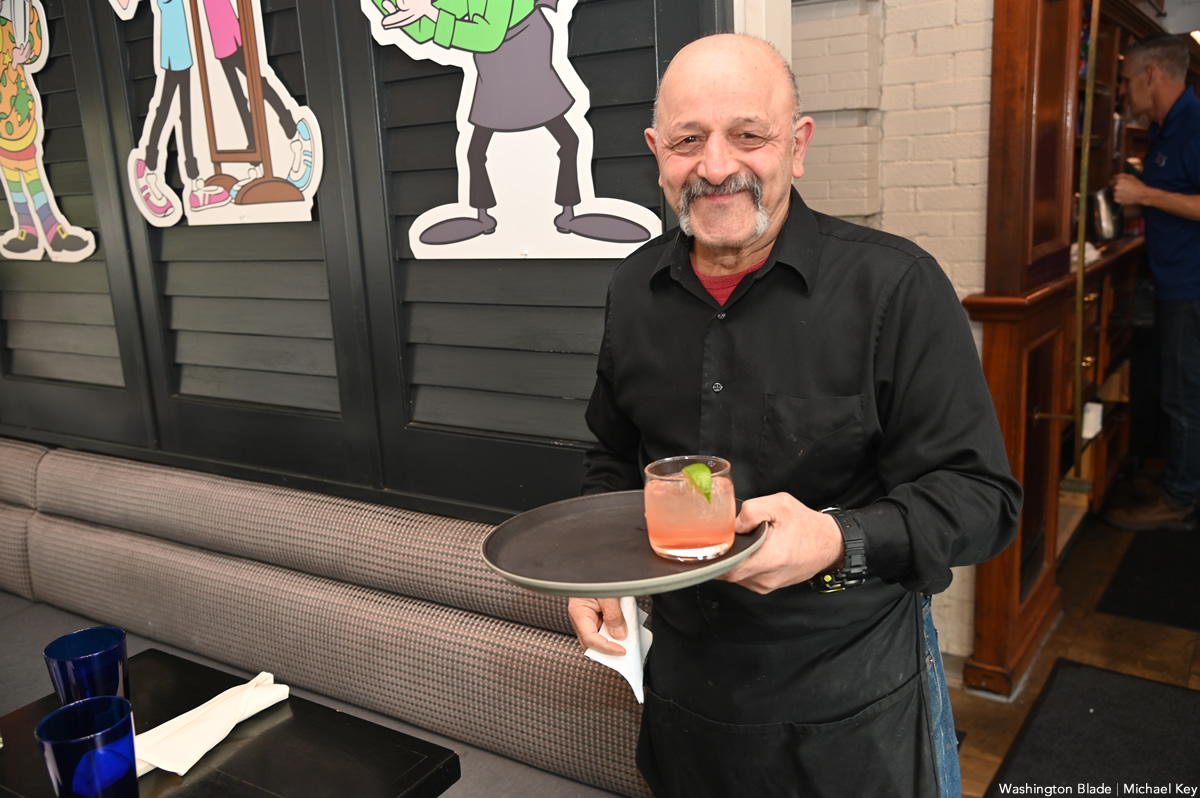
Katinas explained Mano’s passion for Annie’s is infectious and has helped shape the culture of the restaurant. She also explained that his passion reflects how Annie ran the restaurant in years prior, with caring about people at its center.
“He takes young servers under his wing,” Katinas explained. “He takes busboys who don’t speak the shared language, and he treats them with such compassion and generosity. Annie was someone who would always sit and talk with you. She would put her hand on your shoulder and really listen. And Mano does that too.”
“We’re all busy, we’re all running around, but Mano really will sit and take the time to get to know you and to listen to your troubles or happy moments, anything,” Katinas added. “He makes sure, even if he’s across the restaurant and someone walks in the door, he’ll yell ‘Welcome in!’ The sense of hospitality is in his blood.”
Not only is he one of the most passionate people in Annie’s at any given moment, but Katinas also highlighted that he cares about the people and history of Annie’s in a truly unique way.
“He’s like the lighthouse captain,” she said, tearing up and smiling. “He has to be tethered to the building. He doesn’t get too far from it and is like, ‘No, no, I’m going to be at my post.’ He’s always there in the front, and everyone knows to expect him there.”
“He’s got a heart bigger than his entire body,” bar manager Scott Paxton chimed in. “He would do anything for just about anybody. He’s the first one to get here, he’s the last one to leave. He’s the most dedicated out of all of them. He’s always offering to help.”
“For a lot of us, he’s the first person that we met,” Paxton added. “This place has been here for a long time with a long legacy, but he is a big part of that legacy. And so you wander in here for the first time and he’s the person that you meet first.”
“You don’t know where to sit or who’s who, but you probably end up sitting with Mano in his section and so it sort of becomes like your home base,” he said. “There are hundreds and hundreds and hundreds of people that come through here and that’s their first contact with anyone and people that request him. And 40 years later, they come in on Wednesday night and they want to see him.”
Mano’s final thoughts about the restaurant reflected what multiple staff and guests have made clear — he loves Annie’s and will until the end.
“I wish them the best success,” Mano said pointing to Katinas, Paxton, and other staff working at the bar. “And they’re going to have it thanks to everybody, all these years of support for this place.”
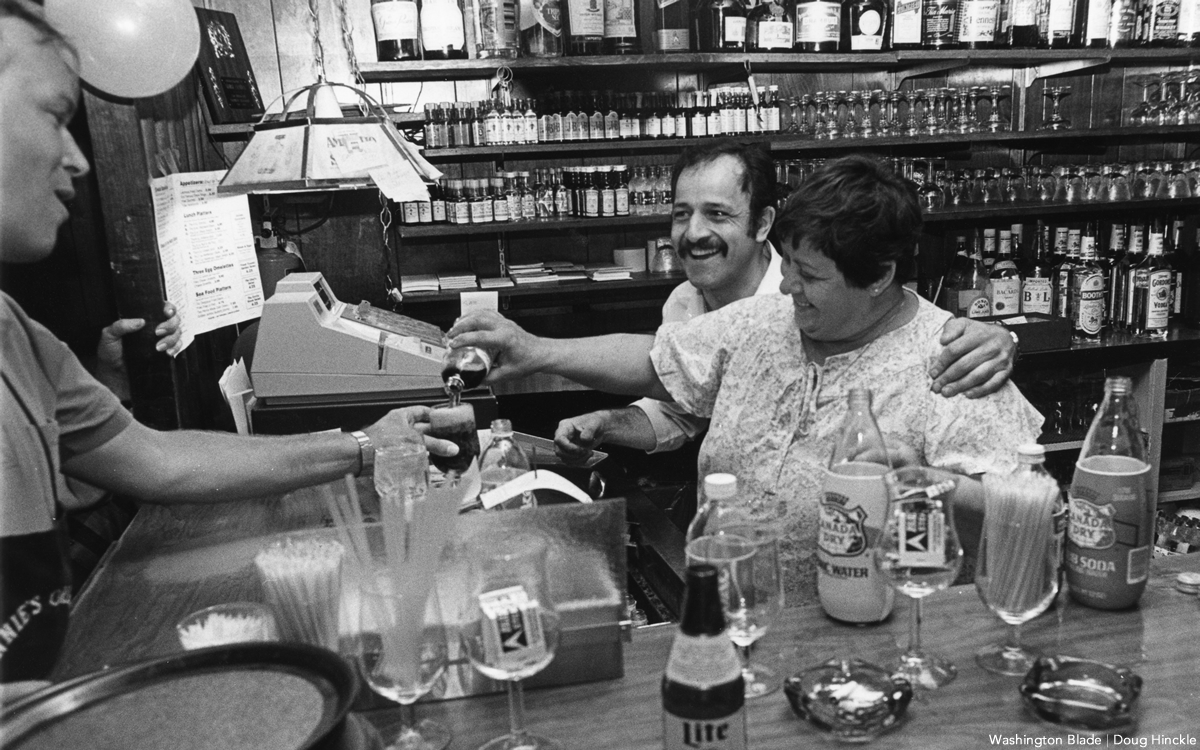
a&e features
Queer highlights of the 2026 Critics Choice Awards: Aunt Gladys, that ‘Heated Rivalry’ shoutout and more
Amy Madigan’s win in the supporting actress category puts her in serious contention to win the Oscar for ‘Weapons’

From Chelsea Handler shouting out Heated Rivalry in her opening monologue to Amy Madigan proving that horror performances can (and should) be taken seriously, the Critics Choice Awards provided plenty of iconic moments for queer movie fans to celebrate on the long road to Oscar night.
Handler kicked off the ceremony by recapping the biggest moments in pop culture last year, from Wicked: For Good to Sinners. She also made room to joke about the surprise hit TV sensation on everyone’s minds: “Shoutout to Heated Rivalry. Everyone loves it! Gay men love it, women love it, straight men who say they aren’t gay but work out at Equinox love it!”
The back-to-back wins for Jacob Elordi in Frankenstein and Amy Madigan in Weapons are notable, given the horror bias that awards voters typically have. Aunt Gladys instantly became a pop culture phenomenon within the LGBTQ+ community when Zach Cregger’s hit horror comedy released in August, but the thought that Madigan could be a serious awards contender for such a fun, out-there performance seemed improbable to most months ago. Now, considering the sheer amount of critics’ attention she’s received over the past month, there’s no denying she’s in the running for the Oscar.
“I really wasn’t expecting all of this because I thought people would like the movie, and I thought people would dig Gladys, but you love Gladys! I mean, it’s crazy,” Madigan said during her acceptance speech. “I get [sent] makeup tutorials and paintings. I even got one weird thing about how she’s a sex icon also, which I didn’t go too deep into that one.”
Over on the TV side, Rhea Seehorn won in the incredibly competitive best actress in a drama series category for her acclaimed performance as Carol in Pluribus, beating out the likes of Emmy winner Britt Lower for Severance, Carrie Coon for The White Lotus, and Bella Ramsey for The Last of Us. Pluribus, which was created by Breaking Bad’s showrunner Vince Gilligan, has been celebrated by audiences for its rich exploration of queer trauma and conversion therapy.
Jean Smart was Hack’s only win of the night, as Hannah Einbinder couldn’t repeat her Emmy victory in the supporting actress in a comedy series category against Janelle James, who nabbed a trophy for Abbott Elementary. Hacks lost the best comedy series award to The Studio, as it did at the Emmys in September. And in the limited series category, Erin Doherty repeated her Emmy success in supporting actress, joining in yet another Adolescence awards sweep.
As Oscar fans speculate on what these Critics Choice wins mean for future ceremonies, we have next week’s Golden Globes ceremony to look forward to on Jan. 11.
a&e features
Looking back at the 10 biggest A&E stories of 2025
‘Wicked,’ Lady Gaga’s new era, ‘Sexy’ Bailey and more

Although 2025 was a year marked by countless attacks on trans rights and political setbacks, the year also saw brilliant queer artists continuing to create art. From Cannes and Sundance Award winners now vying for Oscar consideration to pop icons entering new stages of their careers, queer people persevered to tell their stories through different media.
With the state of the world so uncertain, perhaps there’s no more vital time to celebrate our wins, as seen through some of this year’s top pop culture moments. While there’s no collection of 10 stories that fully encompass “the most important” news, here are some events that got the gays going:
10. ‘Mysterious Gaze of the Flamingo’ wins big at Cannes

The Cannes Film Festival has become a crucial start for films hoping to make their way to the Oscars, and first-time director Diego Céspedes won the top Un Certain Regard prize for his intimate western “The Mysterious Gaze of the Flamingo.” The film is set in the ‘80s and is intended as an allegory for the AIDS epidemic. Seeing a film that unpacks vital queer history win one of the most coveted awards at Cannes has been a huge point of pride in the independent filmmaking community.
Since the film bowed at Cannes, it has been selected as Chile’s Oscar entry in the Best International Feature race. Speaking with The Blade during the film’s AFI Fest run in October, Céspedes said: At first, I was kind of scared to have this campaign position in the times that we’re living [in] here. But at the same time, I think the Oscars mean a huge platform — a huge platform for art and politics.”
9. ‘The Last of Us’ returns for an even gayer season 2
While the first season of The Last of Us gave us one of TV’s most heartbreaking queer love stories in the episode “Long, Long Time,” Season 2 doubled down on its commitment to queer storytelling with the blossoming relationship between Ellie (Bella Ramsey) and Dina (Isabela Merced). The show expanded on the pair’s relationship in the original video game, making it perhaps the central dynamic to the entire season. That unfortunately came with more homophobic backlash on the internet, but those who checked out all the episodes saw a tender relationship form amid the show’s post-apocalyptic, often violent backdrop. For their performance, Ramsey was once again nominated for an Emmy, but Merced deserved just as much awards attention.
8. ‘Emilia Pérez’ sparks controversy
Jacques Audiard’s genre-bending trans musical “Emilia Pérez” proved to be an awards season juggernaut this time last year, winning the Golden Globe for Best Musical/Comedy. But when the lead star Karla Sofia Gascón’s racist, sexist, and homophobic old tweets resurfaced, the film’s Oscar campaign became a tough sell, especially after Netflix had tried so hard to sell Emilia Pérez as the “progressive” film to vote for. Mind you, the film had already received significant backlash from LGBTQ+ audiences and the Mexican community for its stereotypical and reductive portrayals, but the Gascón controversy made what was originally just social media backlash impossible to ignore. The only person who seemed to come out of the whole debacle unscathed was Zoe Saldaña, who won the Oscar for Best Supporting Actress over Ariana Grande.
7. ‘Sorry, Baby’ establishes Eva Victor as major talent
Back in January at the Sundance Film Festival, Eva Victor (known by many for her brand of sketch comedy) premiered their directorial debut “Sorry, Baby” to rave reviews, even winning the Waldo Salt Screening Award. Victor shadowed Jane Schoenbrun on the set of “I Saw the TV Glow,” and seeing Victor come into their own and establish such a strong voice immediately made them one of independent cinema’s most exciting new voices. A memorable scene in the film sees the main character, Agnes (played by Victor), struggling to check a box for male or female, just one example of how naturally queerness is woven into the fabric of the story.
Most recently, Victor was nominated for a Golden Globe for her performance in the film, and she’s represented in a category alongside Jennifer Lawrence (“Die My Love”), Jessie Buckley (“Hamnet”), Julia Roberts (“After the Hunt”), Renate Reinsve (“Sentimental Value”) and Tessa Thompson (“Hedda”). The film also received four Independent Spirit Award nominations overall.
6. Paul Reubens comes out in posthumous doc

While Paul Reubens never publicly came out as gay before passing away in 2023, the two-part documentary “Pee-wee as Himself” premiered back in May on HBO Max, giving the legendary comedian a chance to posthumously open up to the world. Directed by Matt Wolf, the documentary explores how Reubens found his alter ego Pee-Wee Herman and why he kept his private life private.
The documentary won an Emmy in the Outstanding Documentary or Nonfiction Special category and remains one of the most critically acclaimed titles of the year with a 100% Rotten Tomatoes score. Also worth noting, the National Geographic documentary Sally told the posthumous coming out story of Sally Ride through the help of her long-time partner, Tam O’Shaughnessy.
5. Lady Gaga releases ‘Mayhem’
Lady Gaga entered a new phase of her musical career with the release of Mayhem, her seventh album to date. From the frenzy-inducing pop hit Abracadabra to the memorable Bruno Mars duet featured on “Die With a Smile,” seeing Gaga return to her roots and make an album for the most die-hard of fans was especially rewarding after the underwhelming film releases of “House of Gucci” and “Joker: Folie à Deux.” Gaga has been touring with The Mayhem Ball since July, her first arena tour since 2018. She even extended her tour into 2026 with more North American dates, so the party isn’t stopping anytime soon. And Gaga is even set to make an appearance next May in “The Devil Wears Prada 2.”
4. Cynthia Erivo, Ariana Grande perform at the Oscars

While “Wicked: For Good” didn’t quite reach the heights of the first film, we will forever have Cynthia Erivo and Ariana Grande’s breathtaking live performance that opened the 97th Academy Awards. The pair sang a rendition of “Over the Rainbow,” “Home,” and “Defying Gravity,” paying proper homage to the original 1939 “Wizard of Oz.” Even non-Wicked fans can’t deny how magical and brilliantly staged this performance was. With both Erivo and Grande up for acting Oscars last year, they’re hoping to repeat success and make history with consecutive nominations. Either way, let’s hope there’s another live performance in the making, especially with two new original songs (The Girl in the Bubble and No Place Like Home) in the mix.
3. Indya Moore speaks out against Ryan Murphy
Indya Moore has consistently used social media as a platform for activism, and in September, posted a 30-minute Instagram live speaking out against “Pose” co-creator Ryan Murphy. Moore claimed that Murphy wasn’t being a true activist for trans people. “Ryan Murphy, we need you to do more. You need to address the racism, the violence, and the targeting of people on your productions, Ryan Murphy. You do need to make sure trans people are paid equally. Yes, Janet did the right thing,” Moore said. Murphy was also back in the headlines this year for the critically panned “All’s Fair” and the controversial “Monster: The Ed Gein Story” starring Laurie Metcalf and Charlie Hunnam.
2. Cole Escola wins Tony for Best Leading Actor
Few pop culture moments this year brought us together more than Cole Escola winning a Tony award for “Oh, Mary!” the Broadway show they created, wrote and starred in (we love a triple threat!) Escola made history by becoming the first nonbinary person to win a Tony in the leading actor category, and seeing them excitedly rush to the stage wearing a Bernadette Peters-inspired gown instantly became a viral social media moment.
The cherry on top of Escola’s major moment is the recent news that they are writing a Miss Piggy movie with Jennifer Lawrence and Emma Stone producing — news that also broke the internet for the better. We cannot wait!
1. Jonathan Bailey makes gay history as ‘Sexiest Man Alive’

The same year as his on-screen roles in blockbusters “Jurassic World Rebirth” and “Wicked: For Good,” Jonathan Bailey made history as the first openly gay man to be named People magazine’s “Sexiest Man Alive.” The fact that it took 40 years for an openly gay man to earn the title is a signifier of how far we still have to go with queer representation, and seeing Bailey celebrated is just one small step in the right direction.
“There’s so many people that want to do brilliant stuff who feel like they can’t,” he told PEOPLE, “and I know the LGBT sector is under immense threat at the moment. So it’s been amazing to meet people who have the expertise and see potential that I could have only dreamed of.” In 2024, Bailey founded the charity titled The Shameless Fund, which raises money for LGBTQ+ organizations.
a&e features
Your guide to D.C.’s queer New Year’s Eve parties
Ring in 2026 with drag, leather, Champagne, and more

With Christmas in the rear view mirror, we can turn our attention to ringing in a much-anticipated New Year with a slew of local LGBTQ parties. Here’s what’s on tap.
Pitchers
This spacious Adams Morgan bar is hosting the “Pitchers’ Perfect New Year’s Eve.” There will be a midnight Champagne toast, the ball drop on the big screens, and no cover, all night long. The bar doesn’t close until 4 a.m., and the kitchen will be open late (though not until close). All five floors will be open for the party, and party favors are promised.
Trade
D.C.’s hottest bar/club combo is leaning into the Shark motif with its NYE party, “Feeding Frenzy.” The party is a “glitterati-infused Naughty-cal New Year’s Even in the Shark Tank, where the boats are churning and the sharks are circling.” Trade also boasts no cover charge, with doors opening at 5 p.m. and the aforementioned Shark Tank opening at 9 p.m.. Four DJs will be spread across the two spaces; midnight hostess is played by Vagenesis and the two sea sirens sensuously calling are Anathema and Justin Williams.
Number Nine
While Trade will have two DJs as part of one party, Number Nine will host two separate parties, one on each floor. The first floor is classic Number Nine, a more casual-style event with the countdown on TVs and a Champagne midnight toast. There will be no cover and doors open at 5 p.m. Upstairs will be hosted by Capital Sapphics for its second annual NYE gathering. Tickets (about $50) include a midnight Champagne toast, curated drink menu, sapphic DJ set by Rijak, and tarot readings by Yooji.
Crush
Crush will kick off NYE with a free drag bingo at 8 p.m. for the early birds. Post-bingo, there will be a cover for the rest of the evening, featuring two DJs. The cover ($20 limited pre-sale that includes line skip until 11 p.m.; $25 at the door after 9 p.m.) includes one free N/A or Crush, a Champagne toast, and party favors (“the legal kind”). More details on Eventbrite.
Bunker
This subterranean lair is hosting a NYE party entitled “Frosted & Fur: Aspen After Dark New Year’s Eve Celebration.” Arriety from Rupaul Season 15 is set to host, with International DJ Alex Lo. Doors open at 9 p.m. and close at 3 p.m.; there is a midnight Champagne toast. Cover is $25, plus an optional $99 all-you-can-drink package.
District Eagle
This leather-focused bar is hosting “Bulge” for its NYE party. Each District Eagle floor will have its own music and vibe. Doors run from 7 p.m.-3 a.m. and cover is $15. There will be a Champagne toast at midnight, as well as drink specials during the event.
Kiki, Shakiki
Kiki and its new sister bar program Shakiki (in the old Shakers space) will have the same type of party on New Year’s Eve. Both bars open their doors at 5 p.m. and stay open until closing time. Both will offer a Champagne toast at midnight. At Kiki, DJ Vodkatrina will play; at Shakiki, it’ll be DJ Alex Love. Kiki keeps the party going on New Year’s Day, opening at 2 p.m., to celebrate Kiki’s fourth anniversary. There will be a drag show at 6 p.m. and an early 2000s dance party 4-8 p.m.
Spark
This bar and its new menu of alcoholic and twin N/A drinks will host a NYE party with music by DJ Emerald Fox. Given this menu, there will be a complimentary toast at midnight, guests can choose either sparkling wine with or without alcohol. No cover, but Spark is also offering optional wristbands at the door for $35 open bar 11 p.m.-1 a.m. (mid-shelf liquor & all NA drinks).
-

 Sponsored5 days ago
Sponsored5 days agoSafer Ways to Pay for Online Performances and Queer Events
-

 District of Columbia4 days ago
District of Columbia4 days agoTwo pioneering gay journalists to speak at Thursday event
-

 a&e features4 days ago
a&e features4 days agoQueer highlights of the 2026 Critics Choice Awards: Aunt Gladys, that ‘Heated Rivalry’ shoutout and more
-

 Colombia3 days ago
Colombia3 days agoBlade travels to Colombia after U.S. forces seize Maduro in Venezuela

